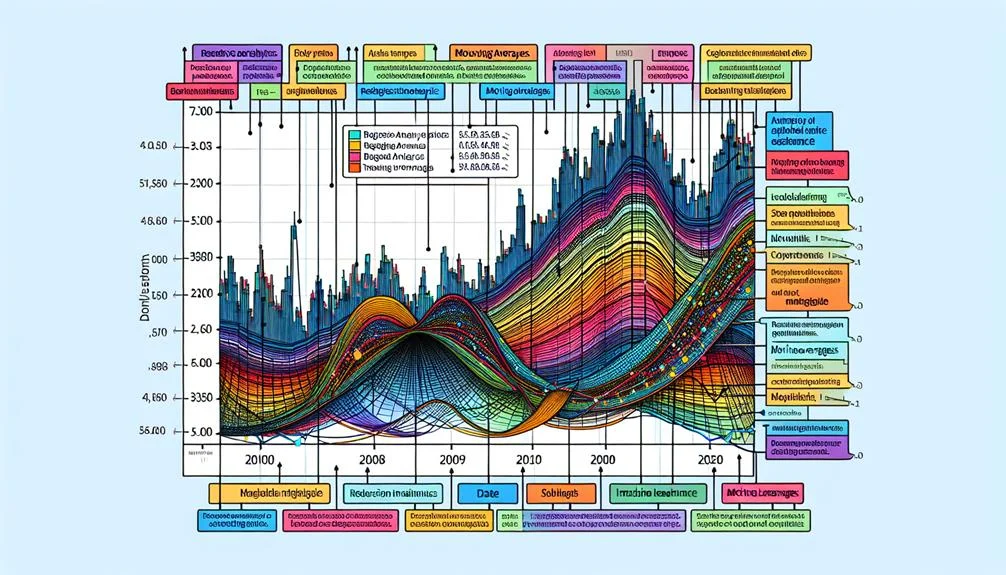In finance, the question of whether data science can accurately predict stock market trends is a topic of ongoing debate among analysts and researchers.
While data science methodologies offer promising tools for extracting insights from vast amounts of data, the complexity of financial markets introduces numerous challenges that can impact the accuracy of predictions.
Understanding how data science intersects with the volatile nature of the stock market requires a exploration of the methodologies, limitations, and potential applications in forecasting market trends.
Key Takeaways
- Utilization of advanced algorithms and predictive models for trend forecasting.
- Analysis of historical data for insight into market trends.
- Data-driven approach revolutionizing stock market prediction accuracy.
- Leveraging time series analysis for trend extrapolation.
- Sentiment analysis tools aid in understanding market behavior.
Stock Market Trends Overview
Through the utilization of advanced algorithms and predictive models, stock market prediction encompasses the analysis of historical data to forecast market trends.
Data science plays a pivotal role in this process by using techniques such as time series analysis, sentiment analysis, and machine learning to predict stock price movements.
By analyzing vast amounts of stock market data, data science provides valuable insights for making informed decisions in the financial sector. This data-driven approach has revolutionized stock market prediction, enabling analysts to anticipate future market patterns accurately.
Predictive analytics in stock market prediction relies on the utilization of past data to forecast upcoming trends and fluctuations in the market. However, it is essential to take into account ethical considerations in this area, such as transparency, bias mitigation, and responsible AI practices.
Ensuring that these ethical considerations are addressed is important for maintaining the integrity and reliability of using data science for stock market trend prediction.
Data Science Techniques for Prediction

Data science techniques for predicting stock market trends encompass machine learning algorithms, time series analysis, and sentiment analysis techniques.
These methodologies enable data scientists to analyze correlations between various factors and stock prices, extract insights from textual financial sources, and build predictive models for forecasting price movements in the stock market.
Machine Learning Algorithms
Utilizing machine learning algorithms is essential to the field of data science for predicting stock market trends with precision and accuracy. These algorithms leverage stock data to forecast future price movements by analyzing historical trends and identifying patterns within financial data.
Techniques such as neural networks and deep learning models like LSTM play a pivotal role in building predictive models for stock market analysis. Random Forest, a popular algorithm in data science, further enhances the accuracy of stock price predictions by creating an ensemble of decision trees.
Python’s machine learning libraries enable data scientists to implement these algorithms effectively and visualize the outcomes, aiding in the interpretation of stock market trends.
| Machine Learning Algorithm | Application | Advantages |
|---|---|---|
| Regression | Predicting stock prices | Interpretable results, easy implementation |
| LSTM | Forecasting stock values | Captures long-term dependencies in data |
| Random Forest | Enhancing prediction accuracy | Handles large datasets, reduces overfitting issues |
Time Series Analysis
Time series analysis in data science explores historical price fluctuations to extrapolate future stock market trends with enhanced accuracy and reliability.
By utilizing historical data, this technique uncovers patterns and trends in stock price movements. Data scientists use time series analysis to forecast future stock market trends by recognizing seasonality, repetitive patterns, and overall trends within stock market data.
This method aids in deciphering the complexities of stock price behavior and facilitates making informed predictions based on past performance.
Through the application of time series analysis, data science can offer valuable insights into the dynamics of the stock market, enabling more accurate predictions of future trends.
By using historical data and identifying patterns, this analytical approach enhances the ability to forecast stock market movements, providing investors and analysts with a data-driven tool for decision-making.
Sentiment Analysis Techniques
Sentiment analysis techniques in data science offers a strategic approach to predicting stock market trends by evaluating public perception and emotional responses towards specific stocks.
This process involves leveraging textual data from various sources like social media, news articles, and forums to gauge market sentiment accurately.
Here are three key aspects of sentiment analysis techniques in data science:
- Natural Language Processing (NLP) Tools: Utilizing NLP techniques, data scientists can extract meaningful insights from textual data to comprehend investor sentiments and emotions related to different stocks.
- Informed Decision-Making: Sentiment analysis plays a critical role in helping traders make informed decisions by considering public perception and market sentiment towards specific stocks.
- Influencing Trading Strategies: Data science leverages sentiment analysis to identify positive or negative sentiments towards stocks, influencing trading strategies and investment decisions effectively. By predicting market trends based on sentiment analysis, traders can adjust their strategies to capitalize on emerging opportunities and mitigate risks.
Role of Machine Learning Algorithms

The selection of machine learning algorithms plays a vital role in predicting stock market trends. Different algorithms have varying impacts on the accuracy and performance of these predictions. Evaluating the performance of these algorithms is essential to determine their effectiveness in forecasting stock price movements.
Algorithm Selection Impact
Algorithm selection plays a vital role in determining the accuracy and efficiency of stock market trend predictions through the application of machine learning techniques.
When considering machine learning algorithms for predicting stock market trends, several factors come into play:
- Predictive Capabilities: Different algorithms such as regression, decision trees, neural networks, SVM, and Random Forests offer varying abilities to predict stock market trends accurately based on historical data patterns.
- Data Complexity: The complexity of stock market data, including the volume and variety of data points, influences the choice of algorithm that can effectively handle and extract meaningful insights from the data.
- Interpretability and Accuracy: The interpretability of results and the desired prediction accuracy are pivotal factors in choosing the most suitable algorithm for predicting stock market trends, as some algorithms may provide more accurate predictions but at the cost of interpretability.
Performance Evaluation Methods
In the context of predicting stock market trends with data science, the evaluation of performance methods plays a pivotal role in gauging the effectiveness of machine learning algorithms utilized for this purpose.
Evaluation methods such as accuracy, precision, recall, and F1 score are commonly employed to assess the performance of predictive models in stock market trend prediction.
Additionally, cross-validation techniques like k-fold validation are essential in preventing overfitting and ensuring the generalizability of the models.
Metrics such as Mean Squared Error (MSE) and Root Mean Squared Error (RMSE) further quantify the accuracy of predictions, providing insights into the model’s performance.
Feature importance analysis is another vital aspect, as it helps identify the key factors influencing stock market trend predictions, allowing for better model refinement and decision-making.
Challenges in Stock Market Prediction

Understanding the complexities of stock market prediction poses major challenges for data scientists due to various factors impacting the accuracy of forecasts. These challenges include:
- Market Volatility: The unpredictable nature of market volatility introduces uncertainty and makes it difficult to achieve accurate predictions using data science models.
- Overfitting: Overfitting occurs when a model fits the training data too closely, leading to poor performance when applied to new data, thereby hindering the accuracy of stock market predictions.
- External Factors: Economic events, geopolitical tensions, and other external influences can significantly impact stock market trends, introducing complexities that make it challenging to predict market movements accurately.
These challenges highlight the intricate landscape of stock market prediction, where data quality issues, market inefficiencies, and the dynamic nature of external factors require robust data science methodologies to generate reliable forecasts.
Importance of Sentiment Analysis

Utilizing sentiment analysis is essential in stock market prediction for evaluating public emotions towards stocks from various sources such as news and social media.
Market sentiment, derived from sentiment analysis, plays a significant role in influencing investor decisions and ultimately impacting stock prices. Data science leverages sentiment analysis to process large volumes of data and understand how public perception drives market trends.
By analyzing sentiment, data science can provide valuable insights into potential price movements and overall market behavior. This analytical approach enhances the accuracy of stock market predictions by incorporating the emotional aspect of market participants.
Understanding the sentiment surrounding specific stocks allows for a more thorough assessment of market dynamics, enabling investors to make informed decisions based on the collective mood of the market.
Essentially, sentiment analysis is a pivotal tool in the toolkit of data scientists aiming to predict stock market trends with a more holistic perspective.
Data Quality for Accurate Predictions

Ensuring high-quality data integrity is fundamental in achieving accurate predictions in stock market analysis. To enhance the reliability of forecasting, consider the following:
- Data Quality:
Clean, accurate, and up-to-date data is essential for precise predictions in stock market trends. Data sources should be validated to guarantee credibility and relevance.
- Data Integrity:
Maintaining data integrity and consistency is vital for deriving reliable insights into market behaviors. Inconsistencies or errors in data can lead to flawed predictions and hinder the accuracy of forecasting models.
- Data Accuracy:
Verifying the accuracy of data is paramount in stock market analysis. Inaccurate or incomplete data can skew predictions and impact the overall effectiveness of forecasting strategies.
Future Trends in Stock Market Forecasting

The evolution of technology is reshaping stock market forecasting methodologies, introducing innovative approaches for more precise and personalized predictions. Machine learning techniques, a subset of data science for stocks, are playing a key role in revolutionizing how we predict the stock market. These techniques analyze vast amounts of data to uncover patterns and trends that impact stock prices in financial markets.
The future of stock market forecasting will likely see a significant impact from advancements in AI and quantum computing. AI will enable the development of more accurate predictive models, while quantum computing will enhance the speed and complexity of calculations involved in predicting future market trends. Additionally, alternative data sources such as satellite imagery are being increasingly leveraged to gain unique insights into stock market movements.
Furthermore, collaborative filtering techniques are set to revolutionize how personalized stock recommendations are generated for investors based on their individual preferences and behaviors. Robo-advisors, powered by data science, are also expected to gain popularity for providing tailored investment advice in the future, further enhancing the accuracy and efficiency of stock market predictions.
Conclusion
To sum up, data science plays a vital role in predicting stock market trends by leveraging advanced algorithms, machine learning models, and sentiment analysis.
Despite the challenges of market complexity and data quality issues, data-driven approaches provide valuable insights for investors and analysts.
Looking ahead, the integration of innovative technologies and data sources will continue to enhance the accuracy and efficiency of stock market forecasting, giving stakeholders a competitive advantage in maneuvering the ever-changing financial landscape.





